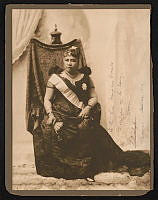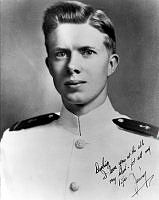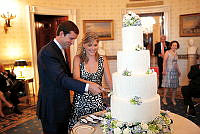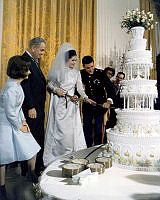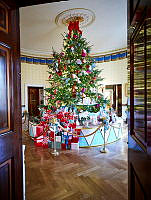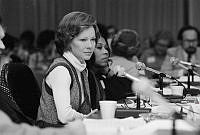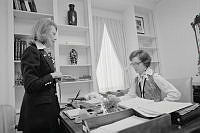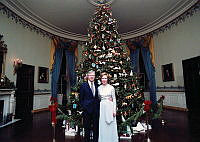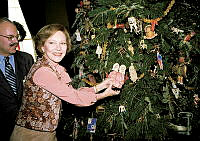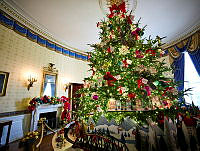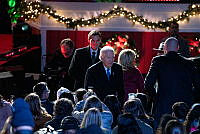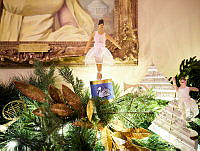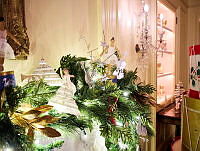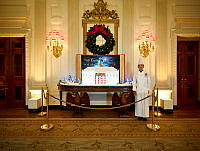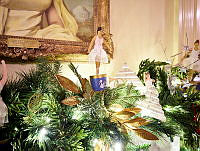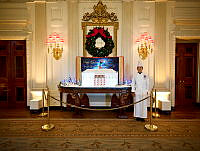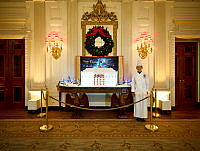Rubenstein Center Scholarship
The Origins of the American "First Lady"
Article 2 Section 1 of the United States Constitution begins with the following: “The executive Power shall be vested in a President of the United States of America.”1 This passage goes on to define the length of the president’s term; how the president will be elected; citizenship and age requirements; presidential succession; compensation; and finally, the presidential oath that all chief executives have sworn to uphold. While there would be many future questions regarding the limitations of executive power, the title and duties of the “President” were firmly entrenched in the Constitution.
But what about the first lady? There is no mention of such a position in our government’s founding document, but like many roles in the White House it took generations of women to shape it into its modern form. As the mounting responsibilities of the president’s wife became more visible at the turn of the twentieth century, public acknowledgement of the role’s importance grew slowly. Over time the title “First Lady” became a distinction bestowed upon current and former ladies of the White House.

Based on a head and bust oil sketch by Gilbert Stuart, Eliphalet Frazer Andrews completed this portrait of Martha Washington in 1878.
White House Collection/White House Historical AssociationNaturally, the first documented reference to a “First Lady” belongs to Martha Washington. This instance, however, first appeared some forty years after her death. The author, “Mrs. Sigourney,” published a remembrance of George Washington’s life and presidency. She wrote of Martha: “The first lady of the nation still preserved the habits of early life.”2 While there are a handful of these mentions in the historical record, there was no definitive moment that the position of “First Lady” came into existence. The language used to describe the White House matriarch varied from “Lady” to “the President’s wife” to “Mrs. President.” In order to understand how the title “First Lady” originated we must explore these descriptions, written by news correspondents and reporters, and how they changed over time. As newspaper coverage and circulation expanded in the twentieth century, the widespread use and acceptance of the title “First Lady” signified a shift in public perception toward the president’s wife. Media outlets began to recognize this prestige and newfound authority by watching one woman who wielded it quite effectively. This transformation emerged during the era of First Lady Eleanor Roosevelt, who used her “unofficial” position to hold press conferences, promote her husband’s New Deal policies, and write columns about civil rights, social inequalities, and education reform.

An 1886 photograph of Frances Folsom Cleveland. Upon marrying President Grover Cleveland in 1886 Frances became the youngest woman to serve as first lady at the age of 21.
Library of CongressThe evolution of the “First Lady” title begins with one of the most popular female residents in White House history. Frances Folsom Cleveland’s attractiveness and youth stimulated public interest in the habits and daily life of the president’s wife. In multiple accounts Frances was identified as “The First Lady of the Land,” a label that quickly gained traction with the American press.3 This trend continued during Caroline Harrison’s time in the President’s House, as reporters were fascinated with the transition between these presidential wives. Harrison also received another title, “First Lady of the Republic.”4 Upon her return to the White House in 1893 Frances Cleveland resumed her “First Lady of the Land” rank, and that title carried forward through the tenures of Ida McKinley, Edith Roosevelt, and Helen Taft.5 As this moniker became more engrained in our political discourse commentators also applied it to former presidential wives and past hostesses of the White House. Martha Washington, Sarah Polk, Betty Taylor, Julia Grant, Harriet Lane, Dolley Madison, Louisa Catherine Adams, and Letitia Tyler Semple were all referred to by this title near the turn of the twentieth century, even though such a designation was not in popular use during their time in the White House.6

Gilbert Stuart's 1804 portrait of Dolley Payne Madison. Madison served as White House hostess for President Thomas Jefferson and later first lady during her husband's administration.
White House Collection/White House Historical AssociationThe phrase “The First Lady of the Land” became so prevalent that it even found its way into American popular culture. Charles Frederic Nirdlinger’s The First Lady of the Land initially opened at the Gaiety Theatre in New York on December 4, 1911. This ahistorical play told the sensationalized story of Dolley Madison and her vacillation between the two loves in her life, James Madison and Aaron Burr. One critic hailed it “a play of much charm” and applauded Nirdlinger’s effort to depict Dolley as “intelligent, self-reliant, diplomatic, and generally speaking, appealing.” The dramatization of a popular first lady’s love affairs, however, prompted criticism from spectators; the “play is neither historical drama nor a transcript from real life. It is romance pure and simple,” concluded a New York Times correspondent.7 Beyond the theater, magazines and journals began publishing more interest pieces on the “First Lady of the Land,” highlighting their formal social duties in the White House, choice of residence décor, fashion and style, and family life. As American readers became more enthralled with the wives of the presidents, these types of articles proliferated between the eras of Ellen Wilson and Lou Hoover.8
During Lou Hoover’s time in the White House the title “First Lady of the Land” was gradually shortened to “First Lady”. As this graph of Washington Post newspaper articles demonstrates, these two titles were used interchangeably from Edith Roosevelt (1901-1909) to Florence Harding (1921-1923), but as the 1920s progressed “First Lady” became the favored title for the president’s wife in the public sphere. Its usage grew rapidly during Lou Hoover’s time in the White House, and then exponentially after the arrival of Eleanor Roosevelt.9

This graph, based on keyword searches of the online database for the Washington Post, shows how often the media used the terms "First Lady of the Land" and "First Lady" between 1901 and 1989.
White House Historical AssociationTwo days after her husband’s momentous 1932 election, Eleanor told one reporter that she disliked the idea of being called “First Lady.” “I never wanted to be a President’s wife,” remarked Eleanor, “and I don’t want it now.”10 She insisted that people simply call her “Mrs. Roosevelt.” While Eleanor was uncomfortable with the label “First Lady,” her position came with a national stage and an eager audience. Between her Red Room press conferences, public lectures, radio show, and her highly syndicated news column “My Day,” Mrs. Roosevelt took the role of the president’s wife and transformed it by expressing support for civil rights, women’s equality, and New Deal programs.11 Her activism bolstered the First Lady title and its significance in American politics, society, and culture. As a result her successors are not only addressed as the “First Lady” but also often measured in comparison to Eleanor’s accomplishments. Many first ladies fought for and achieved major public policy initiatives; others labored tirelessly to preserve the historical integrity of the White House and its collections; but all have used their authority as “First Lady” to serve the American people in some way. While “First Lady” still remains an unofficial position today its transformation, both in terms of title and responsibilities, further illuminates the fluidity of White House positions and how they evolve to meet the demands of changing times and circumstances.

Taken by photographer Jackie Martin, this image shows First Lady Eleanor Roosevelt meeting with her secretary Malvina "Tommy" Thompson, seated, and the social secretary Edith Helm, standing.
Franklin D. Roosevelt Presidential Library and Museum/NARA




